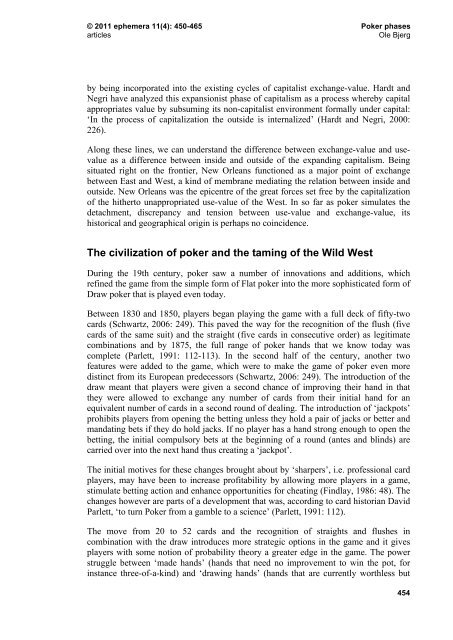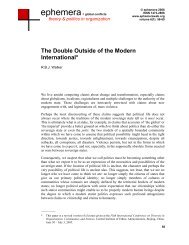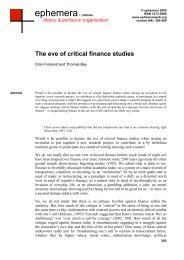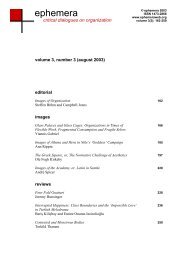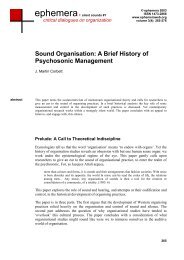Work, play and boredom - Ephemera
Work, play and boredom - Ephemera
Work, play and boredom - Ephemera
You also want an ePaper? Increase the reach of your titles
YUMPU automatically turns print PDFs into web optimized ePapers that Google loves.
© 2011 ephemera 11(4): 450-465 Poker phases<br />
articles Ole Bjerg<br />
by being incorporated into the existing cycles of capitalist exchange-value. Hardt <strong>and</strong><br />
Negri have analyzed this expansionist phase of capitalism as a process whereby capital<br />
appropriates value by subsuming its non-capitalist environment formally under capital:<br />
‘In the process of capitalization the outside is internalized’ (Hardt <strong>and</strong> Negri, 2000:<br />
226).<br />
Along these lines, we can underst<strong>and</strong> the difference between exchange-value <strong>and</strong> usevalue<br />
as a difference between inside <strong>and</strong> outside of the exp<strong>and</strong>ing capitalism. Being<br />
situated right on the frontier, New Orleans functioned as a major point of exchange<br />
between East <strong>and</strong> West, a kind of membrane mediating the relation between inside <strong>and</strong><br />
outside. New Orleans was the epicentre of the great forces set free by the capitalization<br />
of the hitherto unappropriated use-value of the West. In so far as poker simulates the<br />
detachment, discrepancy <strong>and</strong> tension between use-value <strong>and</strong> exchange-value, its<br />
historical <strong>and</strong> geographical origin is perhaps no coincidence.<br />
The civilization of poker <strong>and</strong> the taming of the Wild West<br />
During the 19th century, poker saw a number of innovations <strong>and</strong> additions, which<br />
refined the game from the simple form of Flat poker into the more sophisticated form of<br />
Draw poker that is <strong>play</strong>ed even today.<br />
Between 1830 <strong>and</strong> 1850, <strong>play</strong>ers began <strong>play</strong>ing the game with a full deck of fifty-two<br />
cards (Schwartz, 2006: 249). This paved the way for the recognition of the flush (five<br />
cards of the same suit) <strong>and</strong> the straight (five cards in consecutive order) as legitimate<br />
combinations <strong>and</strong> by 1875, the full range of poker h<strong>and</strong>s that we know today was<br />
complete (Parlett, 1991: 112-113). In the second half of the century, another two<br />
features were added to the game, which were to make the game of poker even more<br />
distinct from its European predecessors (Schwartz, 2006: 249). The introduction of the<br />
draw meant that <strong>play</strong>ers were given a second chance of improving their h<strong>and</strong> in that<br />
they were allowed to exchange any number of cards from their initial h<strong>and</strong> for an<br />
equivalent number of cards in a second round of dealing. The introduction of ‘jackpots’<br />
prohibits <strong>play</strong>ers from opening the betting unless they hold a pair of jacks or better <strong>and</strong><br />
m<strong>and</strong>ating bets if they do hold jacks. If no <strong>play</strong>er has a h<strong>and</strong> strong enough to open the<br />
betting, the initial compulsory bets at the beginning of a round (antes <strong>and</strong> blinds) are<br />
carried over into the next h<strong>and</strong> thus creating a ‘jackpot’.<br />
The initial motives for these changes brought about by ‘sharpers’, i.e. professional card<br />
<strong>play</strong>ers, may have been to increase profitability by allowing more <strong>play</strong>ers in a game,<br />
stimulate betting action <strong>and</strong> enhance opportunities for cheating (Findlay, 1986: 48). The<br />
changes however are parts of a development that was, according to card historian David<br />
Parlett, ‘to turn Poker from a gamble to a science’ (Parlett, 1991: 112).<br />
The move from 20 to 52 cards <strong>and</strong> the recognition of straights <strong>and</strong> flushes in<br />
combination with the draw introduces more strategic options in the game <strong>and</strong> it gives<br />
<strong>play</strong>ers with some notion of probability theory a greater edge in the game. The power<br />
struggle between ‘made h<strong>and</strong>s’ (h<strong>and</strong>s that need no improvement to win the pot, for<br />
instance three-of-a-kind) <strong>and</strong> ‘drawing h<strong>and</strong>s’ (h<strong>and</strong>s that are currently worthless but<br />
454


